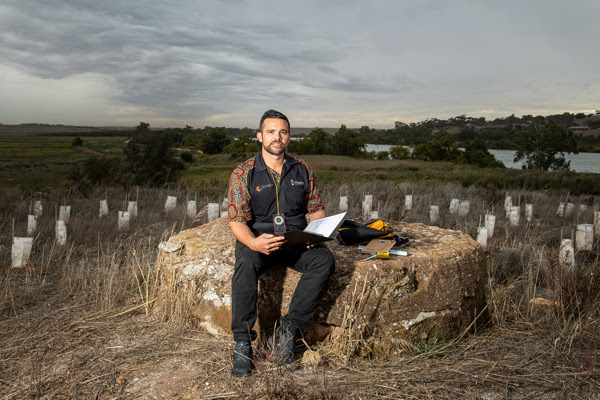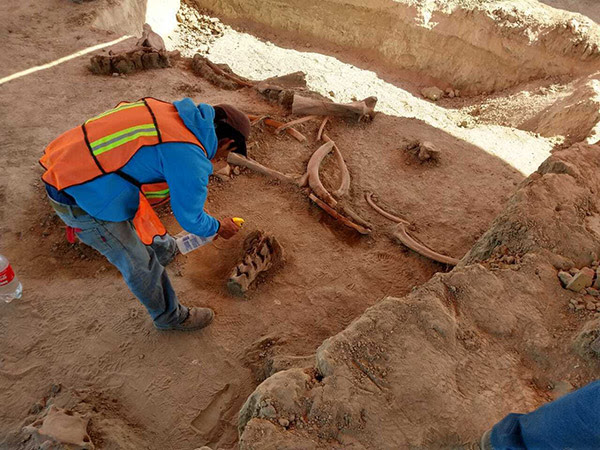| These composite images each show a star (Wolf 359 on the left; Proxima Centauri on the right) as seen from two points of view, one on Earth and the other on the New Horizons probe. (JHUAPL/MSFC/NASA) | |||||
Pluto probe offers view of neighbouring star
NASA’s New Horizons probe has photographed Proxima Centauri — the closest star to the Sun — from the outer reaches of the Solar System.
The 2015 mission to Pluto used a technique to measure the distance of
stars by how they shift in the sky between two vantage points. Such
changes are normally imperceptible to the human eye, but in Proxima’s
case, the star is seen clearly wobbling between New Horizon’s viewpoint
and the Earth’s. In another example of astronomy from deep space, the
Mars rover Curiosity will monitor the erratic star Betelgeuse while it
is not visible from Earth.
Nature | 6 min read
|
|||||
|
|
|||||
Dozens lose jobs amid NIH foreign ties probe
An ongoing investigation into US researchers’ undisclosed financial ties to overseas governments has so far resulted in 54 scientists being fired or resigning,
according to new data from the US National Institutes of Health (NIH).
The investigation began in 2018, and has led to criminal charges being
brought against some prominent researchers. “It’s not what we had hoped,
and it’s not a fun task,” said NIH director Francis Collins. He added
that, of the violations NIH uncovered, about 70% of the researchers had
failed to disclose the receipt of a foreign grant, and more than half
had failed to disclose participation in a foreign talent programme.
Science | 4 min read
|
|||||
|
|
|||||
GitHub to revise ‘master’ and ‘slave’ terms
The software-development site GitHub has said it plans to replace coding terms that reference slavery.
In current developer jargon, a system where a main or ‘master’ version
of the code controls other copies is often described as a master-slave
relationship. But GitHub chief executive Nat Friedman said the firm
wants to replace these terms with neutral language. Google Chrome
developer Una Kravets tweeted
that she would be happy to rename the ‘master’ branch of a project
‘main’, adding: "If it prevents even a single Black person from feeling
more isolated in the tech community, feels like a no-brainer to me.”
BBC News | 3 min read
|
|||||
|
|||||
Notable quotable“Given the global spread, I think we have to consider it endemic now.”
Epidemiologist Azra Ghani says
that, despite successes controlling the disease in some countries, it
looks as though COVID-19 will continue to circulate among people. (New Scientist | 4 min)
|
|||||
|
|||||
Bad hay fever? Blame ‘botanical sexism’
Horticulturalists say cities
might be exacerbating people’s pollen allergies by preferentially
planting male trees. Trees that produce female flowers — or both male
and female ones — are often seen as a nuisance because they drop fruits
and seeds. But planting more female trees instead of pollen producers
could help to reduce the incidence of hay fever. Young male trees
produce relatively little pollen, so their impact worsens as they
mature. “If a lot of allergenic trees are planted in a neighbourhood,
then the pollen load will increase over the years,” says pollen
forecaster Beverley Adams-Groom.
Wired | 8 min read
|
|||||
Quote of the day"I was so nervous when we launched. I guess the more you know about a project, the more you know about the things that can go wrong.”
The Solar Orbiter spacecraft is due to make its first close pass of the Sun today
— known as a perihelion — that will put it between the orbits of Venus
and Mercury. Physicist Tim Horbury, who helped to build the onboard
magnetometer, shares his excitement for upcoming experiments. (BBC News | 5 min read)
|
|||||
|
|
|||||
|
|||||
|
|
Nature Briefing
Nature Briefing
| ||||
Hello Nature readers,
Today we thrill to hints of dark matter from the world’s most sensitive detector, explore the mathematical pitfall that plagues antibody tests and discover a power struggle in the social sciences. |
||||

|
||||
| The XENON1T detector. Visible is the bottom array of photomultiplier tubes, and the copper structure that creates the electric drift field. (Xenon Collaboration) | ||||
Hint of dark matter dazzles physicists
The world’s most sensitive
dark-matter experiment might have found a hint of the stuff — although
the data it has collected so far could be a statistical fluctuation or a
spurious signal. The data collected in 2017-18 by the underground
XENON1T experiment have revealed an excess in the number of particles hitting its liquid xenon, with a relatively low energy.
The finding suggests the possible existence of a hypothetical particle
called the axion. “You cannot overstate the importance of the discovery,
if this is real,” says particle physicist Adam Falkowski. But another
possible explanation is the presence of radioactive impurities. An
upgraded version of the detector called XENONnT could solve the riddle
next year.
Quanta | 6 min read
Source: XENON collaboration preprint
|
||||
|
|
||||
Mathematical pitfall plagues antibody tests
Even if a screening test is
very accurate, if it is not 100% perfect then it will deliver some
false positives and some false negatives. And the lower the infection rate, the more likely it is that a positive result is wrong.
An imperfect antibody test for COVID-19, for example, could leave a lot
of people thinking that they are possibly immune to the disease, when
they have never even had it. Scientific American explains, with a very handy graphic, how this mind-bending fact arises.
Scientific American | 3 min read
|
||||
|
|
||||

|
||||
| In this Nature video, we test a home testing kit that is being sent out across the United Kingdom as part of the government’s testing programme for coronavirus antibodies. And we speak to public-health researcher Christina Atchinson about the REACT (real-time assessment of community transmission) study, run by Imperial College London. (Nature | 4 min video) | ||||
|
|
||||
Emissions surge back to bad old days
In early April, the
international response to the coronavirus pandemic slashed daily global
carbon emissions from fossil fuels by roughly 17%. Now emissions are rebounding, with China almost back to pre-pandemic levels.
The European Union is leading the way to a green recovery with a
proposed US$826-billion recovery package aimed at expanding
renewable-power generation, retrofitting old buildings and investing in
cleaner fuels. Experts estimate that 2020’s global emissions will be
down around 5% compared with last year’s — the biggest drop since the
Second World War, but still not nearly enough.
The New York Times | 5 min read
Read more: How the coronavirus pandemic slashed carbon emissions — in five graphs (Nature, from May) Reference: Nature Climate Change paper & latest update to the supplementary data |
||||
|
||||
Big data revolutionizes social sciences
The masses of user data collected by technology companies are providing social scientists with tools
to do studies they have been dreaming about for more than a century:
from the psychology of morality, to how misinformation spreads, to the
factors that make some artists more successful than others. The goldmine
of information has produced controversies and raised privacy concerns.
And part of the community is resisting the flood in “a power struggle
within the social-science camp”, says analytical sociologist Marc
Keuschnigg. “Who in the end succeeds will claim the label of the social
sciences.”
Nature | 11 min read
|
||||
|
|
||||
Seeking the immune system’s sweet spot
Many of the drugs
under scrutiny for fighting COVID-19 are anti-inflammatory agents.
Researchers hope that these could keep in check the runaway immune
responses — called cytokine storms — that seem to cause dangerous
respiratory problems in some people. But a growing number of frontline critical-care physicians are advocating a more nuanced approach.
They say the goal should be to nudge people towards a ‘Goldilocks’
level of immune activity: not so hot as to cause organ failure, and not
so cold that the virus can run amok.
Nature Reviews Drug Discovery | 14 min read
|
||||
|
|
||||
Boosting research without supporting universities is wrong-headed
By failing to support their universities, countries are undermining their own plans to boost research, argues a Nature editorial. It calls for students and universities to be eligible for the same kinds of temporary emergency funding
as other industries are asking for. In the meantime, senior academics
need to speak up for staff on short-term contracts. And everyone should
look out for students, who are the ‘guinea pigs’ for the new normal.
Nature | 5 min read
|
||||
|
|
||||
A ten-year journey to publish about inequality
Mass violence and
unjust laws have affected the productivity of African American
inventors, found economist Lisa Cook when she analysed patents filed
between 1870 and 1940. But Cook came away baffled when reviewers showed no understanding of the history of Black people in the United States,
or how their experiences could be meaningful to other people. The
experience revealed how economics’ lack of Black representation and
disdain for research about racism is inhibiting the field.
The Indicator podcast | 10 min listen
Reference:
Journal of Economic Growth paper
|
||||
Quote of the day“I ate lunch 31,000ft below the surface of the ocean on Sunday. That's crazy.”
Astronaut and oceanographer Kathy Sullivan, who on 7 June became the first woman to reach the deepest known spot in the ocean,
pays tribute to the ingenuity and skills of the engineers who helped to
make it happen. Sullivan has a heap of other firsts to her name,
including being the first American woman to walk in space. (BBC | 9 min read)
|
||||
|
|
||||
|
||||
|
|
Nature Briefing
| |||||
|
|||||
Hello Nature readers,
Today we learn that the Universe’s coolest lab has created bizarre quantum matter in space, explore how healthy blood vessels might protect children from serious effects of COVID-19 and go on the hunt for the microbial ‘dark matter’ that has never been cultured in the lab. |
|||||

|
|||||
| The International Space Station is home to the Cold Atom Lab — one of the coldest places in the known Universe. (NASA) | |||||
Quantum matter in the coolest place in space
Physicists have made a
Bose–Einstein condensate on the International Space Station.
(Bose–Einstein condensates form when clouds of atoms are chilled to just
above absolute zero and they coalesce into a single macroscopic quantum
object.) The results are a proof-of-principle showing that the Cold
Atom Lab can successfully exploit the microgravity of space in ways that should allow scientists to create phenomena that would be impossible on Earth. The US$100-million facility is on track to become the coldest place in the known Universe.
Nature | 4 min read
Go deeper with the expert view in the Nature News & Views article. Reference: Nature paper |
|||||

|
|||||
| Hear more about the the Cold Atom Lab, plus other top stories, in the Nature Podcast. (22 min listen) | |||||
Hong Kong security law concerns academics
Last month, China’s central
government approved plans to enact a national security law in Hong Kong.
The decision follows a year of protests in the city, which lawmakers
say the new law is going to stop. The law hasn’t been written yet, but some
academics are concerned that it will lead to government interference in
research, restrict international collaborations and increase
self-censorship. Others think research will be unaffected.
Nature | 5 min
|
|||||
Microsoft joins face-recognition moratorium
Following similar announcements by IBM and Amazon, Microsoft has said that it will not sell facial-recognition technology to police departments
in the United States until the technology is regulated at national
level. The company has not said whether it would sell the technology to
federal agencies or to law-enforcement agencies in other countries.
“When even the makers of face recognition refuse to sell this
surveillance technology because it is so dangerous, lawmakers can no
longer deny the threats to our rights and liberties,” says technology
and civil liberties lawyer Matt Cagle.
Washington Post | 4 min read
|
|||||
|
|||||
|
|||||
The search for microbial dark matter
The vast majority of microbes
have still never been cultured in the lab. This microbial ‘dark matter’
could hold useful enzymes, new antimicrobials and other therapeutics.
Researchers are developing technologies to find and grow microbes that have previously been unculturable.
Nature | 9 min read
|
|||||
Scientists tackle motion sickness
Motion sickness has been
affecting humans since time immemorial — and driverless cars,
megaskyscrapers and virtual reality have introduced yet more ways to
make our vestibular systems miserable. Last year, researchers held the
first international conference on motion sickness in Iceland — a country
that knows a thing or two about the perils of life at sea. Icelandic
journalist Egill Bjarnason explores the latest research into motion sickness and its influence on the culture and well-being of his home nation.
Hakai | 15 min read
|
|||||
|
|||||

|
|||||
| In this photograph, taken at Pomberuk, or Hume Reserve, on the River Murray, archaeologist Christopher Wilson sits on what had been the base of a rainwater tank built by the local Aboriginal people between the mid-nineteenth and mid-twentieth centuries. The Ngarrindjeri community is working with the local council to conserve the area, and is regrowing native plants, such as the umbrella bush (Acacia ligulata) seen in the background, to prevent erosion. “As a proud member of the Aboriginal Ngarrindjeri, Kaurna and Latje Latje Nations… this site inspires me because my people have occupied this landscape for tens of thousands of years,” says Wilson. “As I go through the layers of excavation, I’m also pulling back the layers of my history, my culture and my identity.” (Nature | 2 min read) (Iain Bond for Nature) | |||||
Quote of the day“As ‘Black-ademics,’ we’re often the only one. So when these racist acts happen, whether it’s covert or overt, it’s very easy to think, ‘Gosh, I must have done something wrong.’ But when you have this, when you share your experience, you’re able to see that other people have gone through the exact same things.”
Communications researcher Shardé Davis spoke to
Nature
about the Twitter hashtag #BlackInTheIvory, which she co-created with Joy Melody Woods. (Nature | 6 min read)
|
|||||
|
|||||
Bizarre star offers clues to mystery signals
For a fraction of a second in
late April, a hyper-magnetized star in the Milky Way suddenly blasted
out radio energy. Now scientists say that this sudden, strange blip
could help to explain one of astronomy’s biggest puzzles: what powers the hundreds of other mysterious fast radio bursts (FRBs) that have been spotted much farther away in the Universe.
Many astronomers think that fast radio bursts — brief but powerful
cosmic flashes that flare for just milliseconds — come from magnetars,
but haven’t found the link. “Here is something that gets close to the
insane intensity of cosmic FRBs, but that is happening not so far away,”
says astronomer Sarah Burke. “It’s a fantastic opportunity to learn
about at least one of the sources that could be causing FRBs.”
Nature | 5 min read
huge mammoth graveyard has been found under the new Mexico City
airport, explore the two very different coronavirus vaccines reporting
phase 1 clinical results and question whether the pandemic will make or
break research funding.
| |

|
|
| The bones of roughly 60 mammoths were discovered north of Mexico City during the construction of a new airport. Here, an archaeologist works on one of the specimens. (INAH via AP/Shutterstock) | |
Dozens of mammoths under new airport
At least 60 mammoth skeletons
have turned up in excavations for a new airport north of Mexico City —
and more are likely to come. “There are too many, there are hundreds,”
says archaeologist Pedro Sánchez Nava. The site is on what used to be
the shores of a lake called Xaltocan, where a military airport is now
being converted to civilian use. The wealth of remains suggests that mammoths died after being chased by prehistoric humans some 15,000 years ago and getting stuck in the mud.
Smithsonian | 5 min read
|
|
|
|
Subscribe to:
Posts (Atom)


